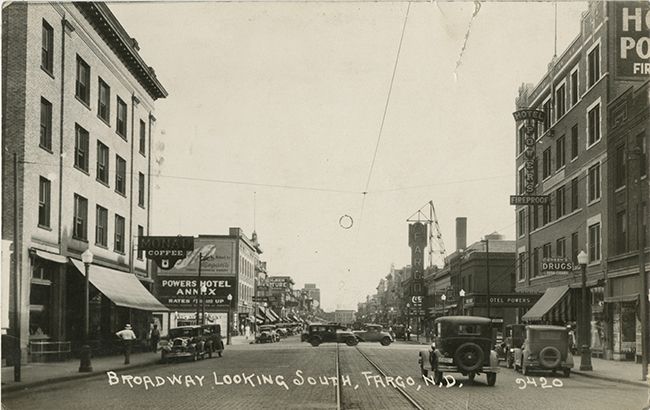
Pre-automobiles, streets were designed for people by default. Pictures of Broadway in the 1920s show a street filled with pedestrians in an active mixed-use environment. On-street parking, heavy foot traffic, and public transportation supported the ground floor retail along Broadway. Traffic moved slowly as a result of the cobblestone streets, the street car, and the pedestrian activity, allowing people to feel comfortable and safe when spending time in the environment.
As the years went on, the once people-friendly design on Broadway turned car-centric. The road transformed first with the removal of the street car, then changed even more as it was paved with concrete, and converted from two to four lanes. The wider street allowed modern cars to move much faster and thus became considerably less pedestrian friendly.
Studies have found drivers tend to base their speed not by the posted speed limits, but by the roadway environment. Wider streets give drivers the feeling that the road is free of hazards, therefore increasing their speed and decreasing their attentiveness. Numerous studies by engineers and transportation agencies find wider streets result in faster speeds.
The tendency to equate wider streets with better streets and design for free-flow traffic is a highly-questionable practice (Institute of Traffic Engineers).
Between 2002-2004, reconstruction of Broadway began. This marked the beginning of Broadway’s transition back to the original pedestrian-friendly designs seen in the 1920s.
By implementing on-street diagonal parking on Broadway, more parking spaces became available for visitors to downtown. This has become a vital element for the success of ground floor retail in Fargo today. The diagonal parking allowed for the addition of sidewalk bump outs at intersections, narrowing the street at pedestrian crosswalks for a safer, more pleasant experience. These essential changes to the street design cause drivers to slow down and be more attentive of their surroundings. Furthermore, slower traffic increased the safety and walkability of downtown.

Broadway 1975- The Red River Mall design of Broadway in 1975 aimed to replicate an indoor mall. One of the flaws of this design was that all on-street parking was removed, which stifled the success of the ground floor retail.
In the 1960s-80s, many of the storefronts were renovated in hopes of competing with the new suburban strip malls and shopping centers. Unfortunately, in most cases, the storefronts were redesigned with limited amounts of glass and doors which made for a less inviting streetscape and hurt retail sales.
Prior to the redesign of Broadway, the City of Fargo initiated a Storefront Rehab program in the late 1990s to incentivize owners to renovate their storefronts back to their original design, in many cases, adding more glass and more frequent doors on the ground floor of buildings. These redesigns created an environment most pedestrians find more pleasing and inviting. The large clear glass on storefronts also generates increased sales for retailers by improving the visibility into their stores. The improved walkability of the downtown neighborhood increased pedestrian activity on Broadway. Today, drivers in downtown Fargo are naturally more cautious and attentive, because the streets are now designed for people, but still accommodate cars. Small changes can make a big difference in making streets safer for pedestrians.
Today, Broadway thrives as a walkable, bikeable, pedestrian friendly street in the heart of downtown Fargo. Credit for its success is largely due to its thoughtful street layout and appealing storefronts designed for pedestrians in mind.
What if other streets in Fargo were designed with people in mind? What if the city reconstructed streets to be more pedestrian friendly like they were in the 20s? What about major corridors like Main, NP Avenue, 1st Avenue, 10th Street North and University Drive? Could these busy roadways flourish like Broadway has over the last 15 years by adopting its pedestrian-centric approach to street and building design?
It wasn’t long ago that Broadway looked like these other streets, and since it changed, it has become a destination for visitors and residents alike. Broadway is a great example of how a pedestrian-friendly street design can spur investment, increase the tax base, and help retail thrive.